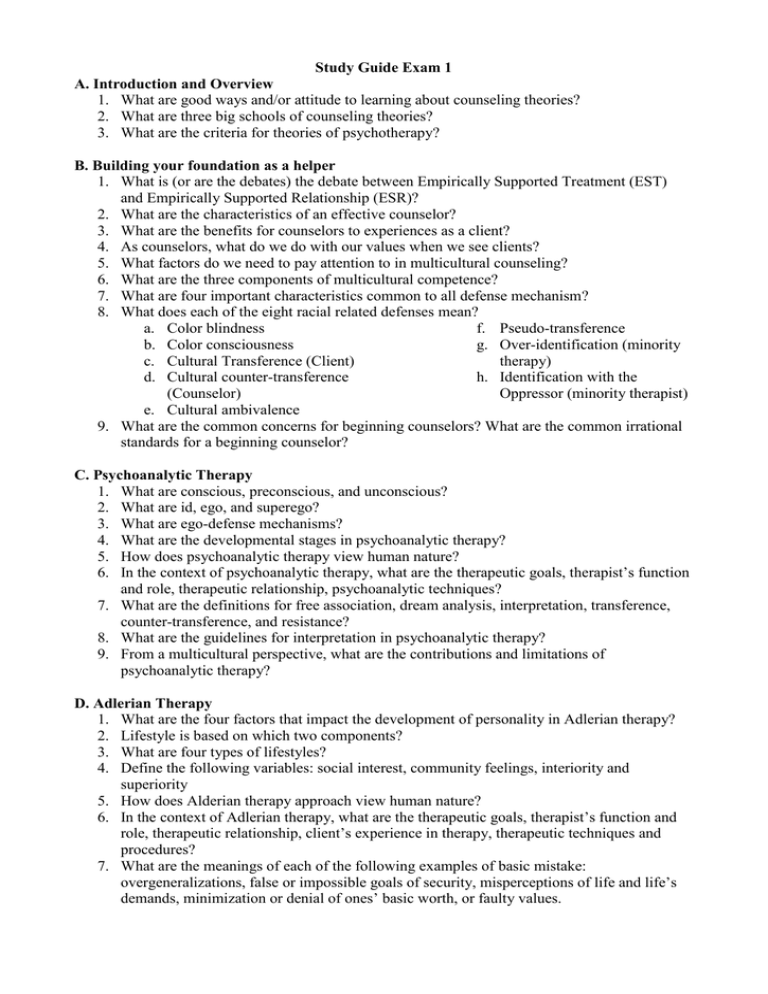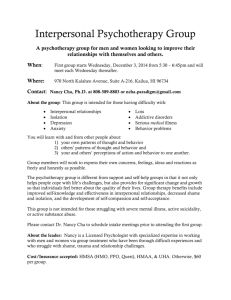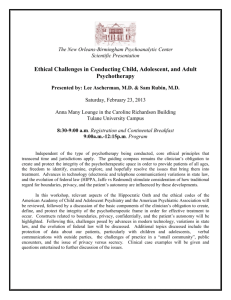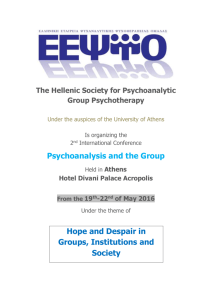Study Guide Exam 1 A. Introduction and Overview
advertisement

Study Guide Exam 1 A. Introduction and Overview 1. What are good ways and/or attitude to learning about counseling theories? 2. What are three big schools of counseling theories? 3. What are the criteria for theories of psychotherapy? B. Building your foundation as a helper 1. What is (or are the debates) the debate between Empirically Supported Treatment (EST) and Empirically Supported Relationship (ESR)? 2. What are the characteristics of an effective counselor? 3. What are the benefits for counselors to experiences as a client? 4. As counselors, what do we do with our values when we see clients? 5. What factors do we need to pay attention to in multicultural counseling? 6. What are the three components of multicultural competence? 7. What are four important characteristics common to all defense mechanism? 8. What does each of the eight racial related defenses mean? a. Color blindness f. Pseudo-transference b. Color consciousness g. Over-identification (minority c. Cultural Transference (Client) therapy) d. Cultural counter-transference h. Identification with the (Counselor) Oppressor (minority therapist) e. Cultural ambivalence 9. What are the common concerns for beginning counselors? What are the common irrational standards for a beginning counselor? C. Psychoanalytic Therapy 1. What are conscious, preconscious, and unconscious? 2. What are id, ego, and superego? 3. What are ego-defense mechanisms? 4. What are the developmental stages in psychoanalytic therapy? 5. How does psychoanalytic therapy view human nature? 6. In the context of psychoanalytic therapy, what are the therapeutic goals, therapist’s function and role, therapeutic relationship, psychoanalytic techniques? 7. What are the definitions for free association, dream analysis, interpretation, transference, counter-transference, and resistance? 8. What are the guidelines for interpretation in psychoanalytic therapy? 9. From a multicultural perspective, what are the contributions and limitations of psychoanalytic therapy? D. Adlerian Therapy 1. What are the four factors that impact the development of personality in Adlerian therapy? 2. Lifestyle is based on which two components? 3. What are four types of lifestyles? 4. Define the following variables: social interest, community feelings, interiority and superiority 5. How does Alderian therapy approach view human nature? 6. In the context of Adlerian therapy, what are the therapeutic goals, therapist’s function and role, therapeutic relationship, client’s experience in therapy, therapeutic techniques and procedures? 7. What are the meanings of each of the following examples of basic mistake: overgeneralizations, false or impossible goals of security, misperceptions of life and life’s demands, minimization or denial of ones’ basic worth, or faulty values. 8. What are four types of personality priorities? Explain each personality priority. 9. Explain the following techniques used in the orientation stages (final stages) of helping process in Adlerian therapy? a. Immediacy b. Encouragement c. Acting as if d. Catching oneself e. Push-button techniques f. Paradoxical intention 10. From a multicultural perspective, what are the contributions and limitations of psychoanalytic therapy? 11. What are the contributions and limitations of psychoanalytic therapy? E. Core Conflictural Relationship Themes 1. What are the three components of CCRT? Please provide definition for each component. 2. What is the goal of CCRT approach? 3. What are the three phases of CCRT treatment? F. Interpersonal Psychotherapy 1. What are the historical context/domains that can be used for case conceptualization in interpersonal psychotherapy? 2. What are the three core concepts in interpersonal psychotherapy? Explain the meanings for each core concept. 3. What is the process of interpersonal psychotherapy approach? 4. What are the three components of working alliance? What is the foundation for building the working alliance? 5. How to deal with the client’s resistance in the interpersonal psychotherapy? 6. How to help clients focus internally for change? 7. How to respond to client’s painful feelings in the interpersonal psychotherapy approach? 8. Please describe Horney’s interpersonal model. That is, what is the process of developing interpersonal coping strategies? 9. What is an interpersonal solution in the interpersonal psychotherapy approach? 10. What are some signals that indicate to the counselors that clients are ready to terminate their therapy? 11. What three components are important for effective termination? G. Person-Center Therapy 1. What are three core concepts in person-center therapy? Please provide definition for each core concept. 2. In general, what kinds of traditional views of therapy that person-center therapy is against? 3. What are the views of human nature in person-center therapy? 4. In the context of person-center therapy, what are the therapeutic goals, therapist’s function, therapist’s role, client’s experience in therapy, relationship between therapist and clients, and therapeutic techniques?




![UW2 - Psychiatric Treatments [2014]](http://s3.studylib.net/store/data/006859622_1-db6167287f6c6867e59a56494e37a7e7-300x300.png)


